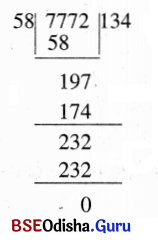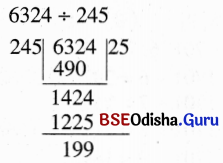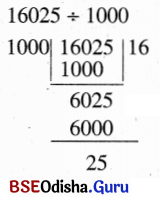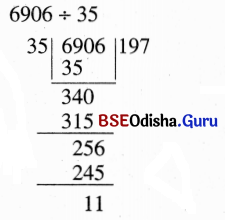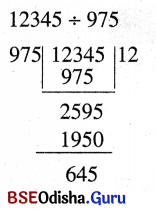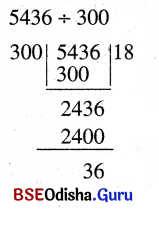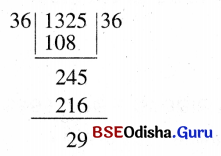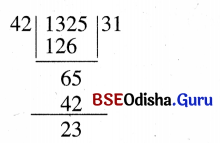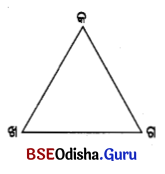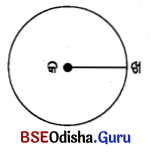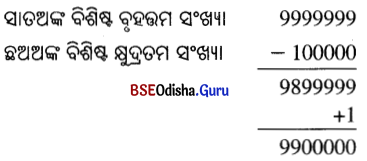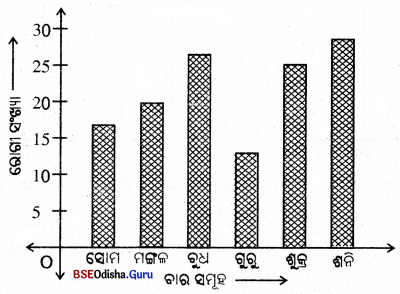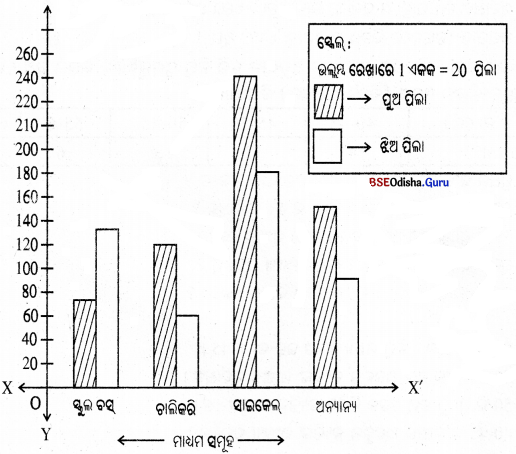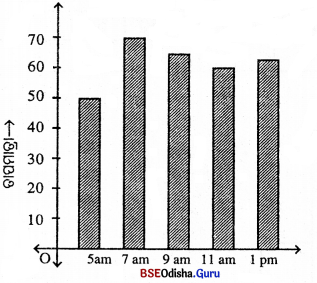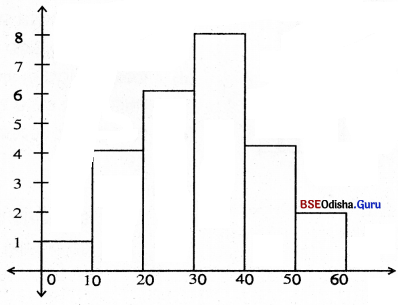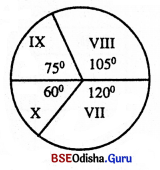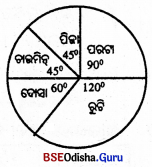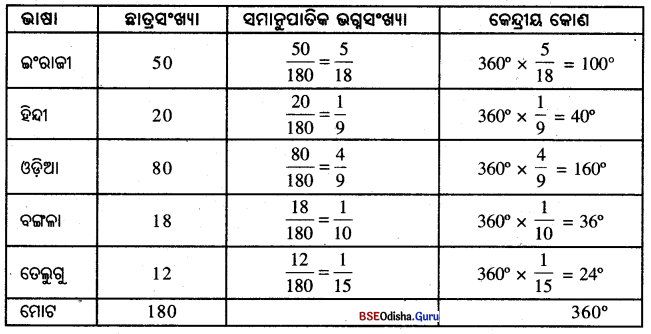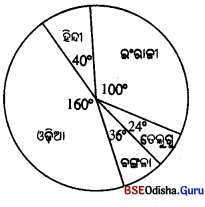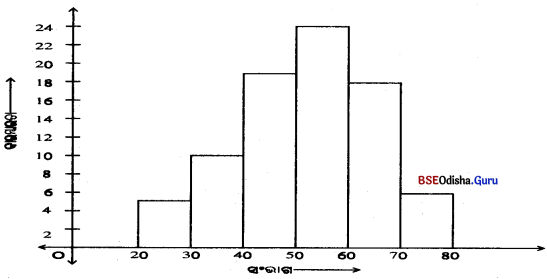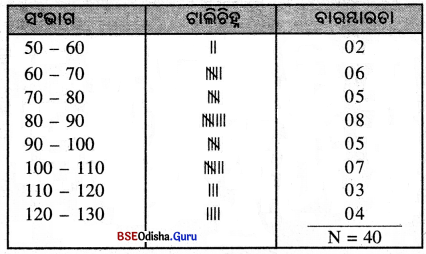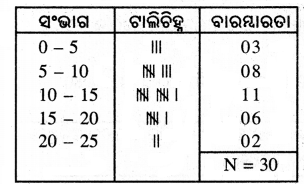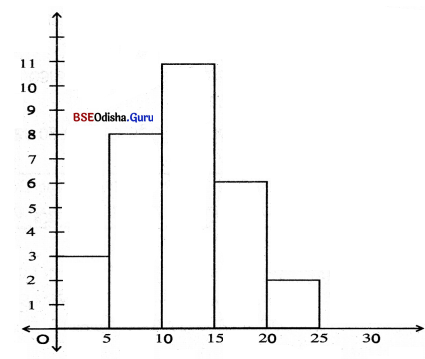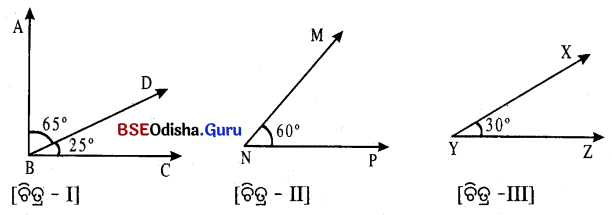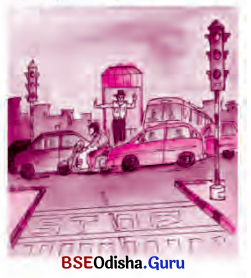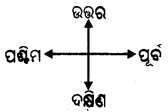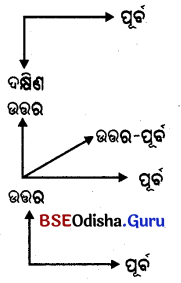Odisha State Board CHSE Odisha Class 12 History Solutions Chapter 5 କଳିଙ୍ଗ ଯୁଦ୍ଧ, ମୌର୍ଯ୍ୟ ଶାସନ Objective Questions.
CHSE Odisha 12th Class History Chapter 5 Objective Questions in Odia Medium
ବସ୍ତୁନିଷ୍ଠ ଓ ଅତିସଂକ୍ଷିପ୍ତ ଉତ୍ତରମୂଳକ ପ୍ରଶ୍ନୋତ୍ତର
A. ସମ୍ଭାବ୍ୟ ଚାରୋଟି ଉତ୍ତର ମଧ୍ୟରୁ ଠିକ୍ ଉତ୍ତରଟି ବାଛି ଲେଖ ।
୧ । ନିମ୍ନୋକ୍ତ କିଏ ଅଶୋକଙ୍କର ପିତା ଥିଲେ ?
(କ) ଚନ୍ଦ୍ରଗୁପ୍ତ
(ଖ) ବିନ୍ଦୁସାର
(ଗ) ସମୁଦ୍ରଗୁପ୍ତ
(ଘ) ବିମ୍ବିସାର
Answer:
(ଖ) ବିନ୍ଦୁସାର
୨। ନିମ୍ନୋକ୍ତ କିଏ ମୌର୍ଯ୍ୟ ବଂଶର ପ୍ରତିଷ୍ଠାତା ଥିଲେ ?
(କ) ଅଶୋକ
(ଖ) ଖାରବେଳ
(ଗ) ବିନ୍ଦୁସାର
(ଘ) ଚନ୍ଦ୍ରଗୁପ୍ତ ମୌର୍ଯ୍ୟ
Answer:
(ଘ) ଚନ୍ଦ୍ରଗୁପ୍ତ ମୌର୍ଯ୍ୟ
୩ । ଅଶୋକ କେବେ ସିଂହାସନ ଆରୋହଣ କରିଥିଲେ ?
(କ) ଖ୍ରୀ.ପୂ. ୨୭୧
(ଖ) ଖ୍ରୀ.ପୂ. ୨୭୫
(ଗ) ଖ୍ରୀ.ପୂ. ୨୭୩
(ଘ) ଖ୍ରୀ.ପୂ. ୨୭୭
Answer:
(ଗ) ଖ୍ରୀ.ପୂ. ୨୭୩

୪ । ସାରନାଥର ବୌଦ୍ଧସ୍ତମ୍ଭ କାହାଦ୍ଵାରା ନିର୍ମିତ ହୋଇଥିଲା ?
(କ) ଅଶୋକ
(ଖ) ବିନ୍ଦୁସାର
(ଗ) ଖାରବେଳ
(ଘ) ଚନ୍ଦ୍ରଗୁପ୍ତ ମୌର୍ଯ୍ୟ
Answer:
(କ) ଅଶୋକ
୫| ଅଶୋକଙ୍କ କେଉଁ ଶିଳାଲେଖରେ କଳିଙ୍ଗ ଯୁଦ୍ଧର ଉଲ୍ଲେଖ ଅଛି ?
(କ) ଦ୍ଵାଦଶ ଶିଳାଲିପି
(ଖ) ଚତୁର୍ଦ୍ଦଶ ଶିଳାଲିପି
(ଗ) ତ୍ରୟୋଦଶ ଶିଳାଲିପି
(ଘ) ଅଷ୍ଟାଦଶ ଶିଳାଲିପି
Answer:
(ଗ) ତ୍ରୟୋଦଶ ଶିଳାଲିପି
୬ | ନିମ୍ନୋକ୍ତ କେଉଁଟି କଳିଙ୍ଗର ରାଜଧାନୀ ଥିଲା ?
(କ) ପାଟଳୀପୁତ୍ର
(ଖ) ତୋଷାଳୀ
(ଗ) ଉଜ୍ଜୟିନୀ
(ଘ) ଚ୍ରହ୍ନପୁତ୍ର
Answer:
(ଖ) ତୋଷାଳୀ
୭। ନିମ୍ନୋକ୍ତ କେଉଁ ବୌଦ୍ଧ ସନ୍ନ୍ୟାସୀଙ୍କଦ୍ଵାରା ଅଶୋକ ବୌଦ୍ଧଧର୍ମରେ ଦୀକ୍ଷିତ ହୋଇଥିଲେ ?
(କ) ମୋଗଲିପୁରତିସ୍
(ଖ) ସାରୀପୁର
(ଗ) ଉପଗୁପ୍ତ
(ଘ) ଶୀଳାଦିତ୍ୟ
Answer:
(ଗ) ଉପଗୁପ୍ତ
୮। ନିମ୍ନୋକ୍ତ ମଧରୁ କେଉଁ ମସିହାରେ ଅଶୋକ କଳିଙ୍ଗ ଆକ୍ରମଣ କରିଥିଲେ ?
(କ) ଖ୍ରୀ.ପୂ. ୨୬୦
(ଖ) ଖ୍ରୀ.ପୂ. ୨୬୫
(ଗ) ଖ୍ରୀ.ପୂ. ୨୬୧
(ଘ) ଖ୍ରୀ.ପୂ. ୨୬୬
Answer:
(ଗ) ଖ୍ରୀ.ପୂ. ୨୬୧

୯ । ଅଶୋକ ନିଜର ନୀତିକୁ କାର୍ଯ୍ୟକାରୀ କରିବାପାଇଁ କେଉଁ ନାମଧେୟ ଏକ ନୂତନ କର୍ମଚାରୀ ଶ୍ରେଣୀ ସୃଷ୍ଟି କରିଥିଲେ ?
(କ) କର୍ମ ମହାମାତ୍ର
(ଖ) ଯୁଦ୍ଧ ମହାମାତ୍ର
(ଗ) ଧର୍ମ ମହାମାତ୍ର
(ଘ) ଶାନ୍ତି ମହାମାତ୍ର
Answer:
(ଗ) ଧର୍ମ ମହାମାତ୍ର
୧୦। ଅଶୋକ ଧର୍ମପ୍ରଚାର ପାଇଁ ନିଜର ପୁତ୍ର ଓ କନ୍ୟାଙ୍କୁ କେଉଁ ସ୍ଥାନକୁ ପ୍ରେରଣ କରିଥିଲେ ?
(କ) ସିଂହଳ
(ଖ) ବର୍ମା
(ଗ) ଆଫଗାନିସ୍ଥାନ
(ଘ) ଚୀନ୍
Answer:
(କ) ସିଂହଳ
୧୧। ନିମ୍ନୋକ୍ତ କେଉଁ ମସିହାରେ ଅଶୋକ ମୃତ୍ୟୁବରଣ କରିଥିଲେ ?
(କ) ଖ୍ରୀ.ପୂ. ୨୫୯
(ଖ) ଖ୍ରୀ.ପୂ. ୨୩୨
(ଗ) ଖ୍ରୀ.ପୂ. ୨୬୧
(ଘ) ଖ୍ରୀ.ପୂ. ୨୬୫
Answer:
(ଖ) ଖ୍ରୀ.ପୂ. ୨୩୨
୧୨। ନିମ୍ନୋକ୍ତ କେଉଁ ମସିହାରେ ଚନ୍ଦ୍ରଗୁପ୍ତ ମୌର୍ଯ୍ୟ ମୌର୍ଯ୍ୟ ସାମ୍ରାଜ୍ୟ ପ୍ରତିଷ୍ଠା କରିଥିଲେ ।
(କ) ଖ୍ରୀ.ପୂ. ୩୨୧
(ଖ) ଖ୍ରୀ.ପୂ. ୩୨୮
(ଗ) ଖ୍ରୀ.ପୂ. ୩୨୯
(ଘ) ଖ୍ରୀ.ପୂ. ୩୩୦
Answer:
(କ) ଖ୍ରୀ.ପୂ. ୩୨୧
୧୩। କାହାକୁ ‘ଦେବାନାଂ ପ୍ରିୟଦର୍ଶୀ’ ବୋଲି ଅଭିହିତ କରାଯାଇଛି ?
(କ) ଅଶୋକ
(ଖ) ଖାରବେଳ
(ଗ) ଚନ୍ଦ୍ରଗୁପ୍ତ ମୌର୍ଯ୍ୟ
(ଘ) ବିନ୍ଦୁସାର
Answer:
(କ) ଅଶୋକ

୧୪। ମୌର୍ଯ୍ୟ ଶାସନ ବିଷୟରେ ଜାଣିବାପାଇଁ କେଉଁ ରାଜାଙ୍କ ଅଭିଲେଖ ଅଧୁକ ଗୁରୁତ୍ଵପୂର୍ଣ୍ଣ ?
(କ) ଅଶୋକ
(ଖ) ଖାରବେଳ
(ଗ) ଚନ୍ଦ୍ରଗୁପ୍ତ ମୌର୍ଯ୍ୟ
(ଘ) ସମୁଦ୍ରଗୁପ୍ତ
Answer:
(କ) ଅଶୋକ
୧୫। ମୌର୍ଯ୍ୟ ସରକାର ନିମ୍ନୋକ୍ତ କେଉଁ ଶାସନ ଉପରେ ପ୍ରତିଷ୍ଠିତ ଥିଲା ?
(କ) ରାଜତନ୍ତ୍ର
(ଖ) ସଂଘୀୟ
(ଗ) ଗଣତନ୍ତ୍ର
(ଘ) ଏକଚ୍ଛତ୍ରବାଦ
Answer:
(କ) ରାଜତନ୍ତ୍ର
୧୬। ନିମ୍ନୋକ୍ତ କିଏ ରାଜାଙ୍କର ମୁଖ୍ୟ ଉପଦେଷ୍ଟା ଥିଲେ ?
(କ) ସେନାପତି
(ଖ) ପ୍ରଧାନମନ୍ତ୍ରୀ
(ଗ) ପୁରୋହିତ
(ଘ) ମନ୍ତିମଣ୍ତଳ
Answer:
(ଖ) ପ୍ରଧାନମନ୍ତ୍ରୀ
୧୭। ମୌର୍ଯ୍ୟ ରାଜାଙ୍କ ଧର୍ମ ଉପଦେଷ୍ଟାଙ୍କୁ କ’ଣ କୁହାଯାଉଥିଲା ?
(କ) ରାଜପୁତ୍ର
(ଖ) ପୁରୋହିତ
(ଗ) ଧର୍ମ ମହାମାତ୍ର
(ଘ) ସେନାପତି
Answer:
(ଖ) ପୁରୋହିତ
୧୮। କଳିଙ୍ଗ ଯୁଦ୍ଧ ଅଶୋକଙ୍କଠାରେ କି ପରିବର୍ତ୍ତନ ଆଣିଥିଲା ?
(କ) ଚଣ୍ଡାଶୋକରୁ ମହାଚଣ୍ଡାଶୋକ
(ଗ) ମଗଧ ସମ୍ରାଟରୁ କଳିଙ୍ଗ ସମ୍ରାଟ
(ଖ) ଚଣ୍ଡାଶୋକରୁ ଧର୍ମାଶୋକ
(ଘ) ରାଜ୍ୟଜୟରୁ ଦିଗ୍ବିଜୟୀ
Answer:
(ଖ) ଚଣ୍ଡାଶୋକରୁ ଧର୍ମାଶୋକ

୧୯। କଳିଙ୍ଗ ଯୁଦ୍ଧପରେ ଅଶୋକ ନିମ୍ନୋକ୍ତ ମଧ୍ୟରୁ କେଉଁଟିକୁ ତ୍ୟାଗ କରିଥିଲେ ?
(କ) ଗୃହତ୍ୟାଗ
(ଖ) ଅସ୍ତ୍ର ତ୍ଯାଗ
(ଗ) ଆମିଷ ତ୍ୟାଗ
(ଘ) ଭୋଜନ ତ୍ଯାଗ
Answer:
(ଖ) ଅସ୍ତ୍ର ତ୍ୟାଗ
୨୦। ମୌର୍ଯ୍ୟ ଶାସନରେ ନିମ୍ନୋକ୍ତ କେଉଁ ପ୍ରଥା ସମ୍ପର୍କରେ କୌଟିଲ୍ୟଙ୍କ ଲେଖାରୁ ଆଭାସ ମିଳିଥାଏ ?
(କ) ବାଲ୍ୟବିବାହ ପ୍ରଥା
(ଖ) ଗୁପ୍ତଚର ପ୍ରଥା
(ଗ) ଡାକ ପ୍ରଥା
(ଘ) ନରବଳି ପ୍ରଥା
Answer:
(ଖ) ଗୁପ୍ତଚର ପ୍ରଥା
୨୧। ଅଶୋକ କେଉଁ ଭାଷାର ପୃଷ୍ଠପୋଷକତା କରିଥିଲେ ?
(କ) ବ୍ରାହ୍ମୀ
(ଖ) ପାଲୀ
(ଗ) ହିଦା
(ଘ) ଆରବୀ
Answer:
(ଖ) ପାଲୀ
୨୨। ଭୌଗୋଳିକ ଦୃଷ୍ଟିକୋଣରୁ କଳିଙ୍ଗ ରାଜ୍ୟ ମଗଧ ସାମ୍ରାଜ୍ୟର କେଉଁ ଦିଗରେ ଅବସ୍ଥିତ ଥିଲା ?
(କ) ଉତ୍ତର
(ଖ) ପୂର୍ବ
(ଗ) ପଶ୍ଚିମ
(ଘ) ଦଷିଣ
Answer:
(ଖ) ପୂର୍ବ
୨୩। ସିଂହାସନ ଆରୋହଣର କେଉଁ ବର୍ଷରେ ଅଶୋକ କଳିଙ୍ଗ ଆକ୍ରମଣ କରିଥିଲେ ?
(କ) ଦଶମ
(ଖ) ଏକାଦଶ
(ଗ) ଦ୍ଵାଦଶ
(ଘ) ତ୍ରୟୋଦଶ
Answer:
(ଗ) ଦ୍ଵାଦଶ

୨୪। ଅଶୋକଙ୍କ ପାଇଁ କଳିଙ୍ଗ ଯୁଦ୍ଧ କ’ଣ ଥୁଲା ?
(କ) ଦ୍ଵିତୀୟ ଯୁଦ୍ଧ
(ଖ) ପ୍ରଥମ ଓ ଶେଷ ଯୁଦ୍ଧ
(ଗ) ତୃତୀୟ ଓ ଶେଷ ଯୁଦ୍ଧ
(ଘ) ଚତୁର୍ଥ ଯୁଦ୍ଧ
Answer:
(ଖ) ପ୍ରଥମ ଓ ଶେଷଯୁଦ୍ଧ
B. ଶୂନ୍ୟସ୍ଥାନ ପୂରଣ କର ।
୧ । ନନ୍ଦ ବଂଶର ଶେଷ ରାଜା ଥିଲେ _________ ।
Answer:
ଧନନନ୍ଦ
୨। ମେଘାସ୍ଥିନିସ୍ଙ୍କର ପୁସ୍ତକର ନାମ __________ ଥିଲା ।
Answer:
ଇଣ୍ଡିକା
୩। ଚନ୍ଦ୍ରଗୁପ୍ତ ମୌର୍ଯ୍ୟ ସମ୍ଭବତଃ ଖ୍ରୀ.ପୂ. ____________ ରେ ମୌର୍ଯ୍ୟ ସାମ୍ରାଜ୍ୟ ପ୍ରତିଷ୍ଠା କରିଥିଲେ ।
Answer:
୩୨୧
୪। ଅଶୋକଙ୍କ ସମୟରେ ମୌର୍ଯ୍ୟ ରାଜ୍ୟ ଏକ ସମ୍ପୂର୍ଣ _________ ରାଜ୍ୟରେ ପରିଣତ ହୋଇଥିଲା ।
Answer:
ଜନମଙ୍ଗଳ

୫ । ପୁରାତନ ବିଶ୍ବର ସବୁ ସାମ୍ରାଜ୍ୟଗୁଡ଼ିକ ମଧ୍ୟରେ ________ ସାମ୍ରାଜ୍ୟ ଥିଲା ବୃହତ୍ତମ ।
Answer:
ମୌର୍ଯ୍ୟ
୬ । ଅଶୋକଙ୍କୁ ଖ୍ରୀଷ୍ଟଧର୍ମର _________ ଙ୍କ ସହିତ ତୁଳନା କରାଯାଏ ।
Answer:
ସେଣ୍ଟ ପଲ୍
୭। _________ ଥିଲେ ମୌର୍ଯ୍ୟ ଶାସନର କେନ୍ଦ୍ରବିନ୍ଦୁ ।
Answer:
ରାଜା
୮। ________ ଙ୍କୁ ପ୍ରଥମ ଜାତୀୟ ସମ୍ରାଟ ରୂପେ ମାନ୍ୟତା ପ୍ରଦାନ କରାଯାଇଥାଏ ।
Answer:
ଚନ୍ଦ୍ରଗୁପ୍ତ
୯। ଅଶୋକଙ୍କ ସମୟରେ ମନ୍ତିପରିଷଦ ________ ନାମରେ ବିଦିତ ଥିଲା ।
Answer:
ପରିଷା
୧୦। ଅଶୋକଙ୍କ ସମୟରେ ରାଜସ୍ୱ ଆଦାୟ ମୁଖ୍ୟଙ୍କୁ _________ କୁହାଯାଉଥିଲା ।
Answer:
ସମାହର
୧୧। ମୌର୍ଯ୍ୟ ରାଜତ୍ଵରେ ଗୃହ ପ୍ରତିରକ୍ଷା କର୍ମଚାରୀଙ୍କୁ ________ କୁହାଯାଉଥିଲା ।
Answer:
ଦୁର୍ଗପାଳ

୧୨। ମୌର୍ଯ୍ୟ ରାଜତ୍ଵ ସମୟରେ ରାଜଧାନୀର ମୁଖ୍ୟ ତତ୍ତ୍ଵାବଧାରକଙ୍କୁ ________ କୁହାଯାଏ ।
Answer:
ମୌର
୧୩ । ଅଭିଷେକର ________ ବର୍ଷ ପରେ ଅଶୋକ ‘ଧର୍ମ ମହାପାତ୍ର’ମାନଙ୍କୁ ନିଯୁକ୍ତ ଦେଇଥିଲେ ।
Answer:
୧୩
୧୪। ମୌର୍ଯ୍ୟ ବଂଶର ଶେଷ ଶାସକ ________ ଥିଲେ ।
Answer:
ବୃହଦ୍ରଥ
୧୫। ବିଚାର ବିଭାଗରେ ସାମ୍ୟତା ରକ୍ଷା କରିବାପାଇଁ ସମ୍ରାଟ ___________ ଦଣ୍ଡ ସମତା ଓ ବ୍ୟବହାର ସମତା ପ୍ରଚଳନ କରିଥିଲେ ।
Answer:
ଅଶୋକ
୧୬। କଳିଙ୍ଗ ଯୁଦ୍ଧପରେ ଭେରୀଘୋଷ _________ ଘୋଷରେ ପରିଣତ ହୋଇଥିଲା ।
Answer:
ଧର୍ମ
୧୭। କୌଟିଲ୍ୟଙ୍କ ମତରେ ସେ ସମୟରେ ________ ନ୍ୟାୟାଳୟରେ ସାମାଜିକ ଓ ଦିୱାନୀ ଏବଂ __________ ନ୍ୟାୟାଳୟରେ ଫୌଜଦାରୀ ସଂକ୍ରାନ୍ତୀୟ ମକଦ୍ଦମା ବିଚାର କରାଯାଉଥିଲା ।
Answer:
ଧର୍ମସ୍ଥାୟ, କଣ୍ଟକଶୋଧନ

୧୮। ଅଶୋକଙ୍କ ପୁତ୍ର ________ ତକ୍ଷଶିଳାର ଶାସନକର୍ତ୍ତା ଥିଲେ ।
Answer:
କୁନାଳ
୧୯ । ଖ୍ରୀ.ପୂ. ___________ ରେ ଅଶୋକ ମୃତ୍ୟୁବରଣ କରିଥିଲେ ।
Answer:
୨୩୨
୨୦ । _________ ର ମୁଖ୍ୟମାନଙ୍କୁ ବିଷୟପତି କୁହାଯାଉଥିଲା ।
Answer:
ଜିଲ୍ଲା
୨୧। ଜିଲ୍ଲା କର୍ମଚାରୀମାନଙ୍କୁ _______ ନିଯୁକ୍ତି ଦେଉଥିଲେ ।
Answer:
ପ୍ରାଦେଶିକ ଶାସନକର୍ତ୍ତା
୨୨। ଅଶୋକଙ୍କ ସମୟରେ ଜିଲ୍ଲାସ୍ତରୀୟ ରାଜକୋଷ ________ ମାନଙ୍କ ଅଧୀନରେ ପରିଚାଳିତ ହେଉଥିଲା ।
Answer:
ଯୁକ୍ତ
୨୩ । ଅର୍ଥଶାସ୍ତ୍ରରୁ ଜଣାଯାଏ ଯେ _________ ଥିଲା ସ୍ଥାନୀୟ ଶାସନର ସର୍ବନିମ୍ନ ସଂସ୍ଥା ।
Answer:
ଗ୍ରାମ

୨୪। ମୌର୍ଯ୍ୟ ରାଜତ୍ଵ ସମୟରେ ଜିଲ୍ଲାର ଆଇନ ଶୃଙ୍ଖଳା କରିବା ଦାୟିତ୍ଵ _________ ଙ୍କର ଥିଲା ।
Answer:
ବିଷୟପତି
୨୫। ମେଘାସ୍ଥିନିସ୍ଙ୍କ ବିବରଣୀରୁ ଜଣାଯାଏ ଯେ ସେତେବେଳେ ନଗରଗୁଡ଼ିକରେ __________ ଶାସନ ପ୍ରବର୍ତ୍ତନ କରାଯାଇଥିଲା ।
Answer:
ସ୍ୱାୟତ୍ତ
୨୬। ଶ୍ରମିକମାନଙ୍କର କାର୍ଯ୍ୟ __________ ତଦାରଖ କରୁଥିଲେ ।
Answer:
ଗୋପ
C. ଗୋଟିଏ ବାକ୍ୟରେ ଉତ୍ତର ଲେଖ ।
୧| ଭାରତ ବାହାରେ କେଉଁ କେଉଁ ଦେଶରେ ବୌଦ୍ଧଧର୍ମ ପ୍ରସାର ଲାଭ କରିଥିଲା ?
Answer:
ବାହାର ବାହାରେ ସିଂହଳ, ସିରିଆ, ତିବ୍ଦତ, ମାସିଡ଼ନ୍, ମିଶର ଆଦି ଦେଶରେ ବୌଦ୍ଧଧର୍ମ ପ୍ରସାର ଲାଭ କରିଥିଲା ।
୨। ମୌର୍ଯ୍ୟ ଶାସନ ବିଷୟରେ ଜାଣିବାପାଇଁ କେଉଁ ରାଜାଙ୍କ ଅଭିଲେଖ ଅଧିକ ଗୁରୁତ୍ଵପୂର୍ଣ୍ଣ ?
Answer:
ମୌର୍ଯ୍ୟ ଶାସନ ବିଷୟରେ ଜାଣିବାପାଇଁ ସମ୍ରାଟ ଅଶୋକଙ୍କ ଅଭିଲେଖ ଅଧିକ ଗୁରୁତ୍ଵପୂର୍ଣ୍ଣ ।
୩। ଅଶୋକଙ୍କଦ୍ଵାରା ନିର୍ମିତ ଦୁଇଟି କଳାକୃତିର ନାମ ଲେଖ ।
Answer:
ସାଵିସ୍ତୂପ ଓ ସାରନାଥସ୍ଥିତ ସ୍ତମ୍ଭ ଅଶୋକଙ୍କର ଦୁଇଟି ମୁଖ୍ୟ କଳାକୃତି ଅଟେ ।

୪ । ଅଶୋକଙ୍କ ଅନୁଶାସନ କହିଲେ କ’ଣ ବୁଝ ?
Answer:
ବୌଦ୍ଧଧର୍ମର ବାଣୀ ଓ ମହତ୍ ଉପଦେଶ ବହନ କରିଥିବା ଅଭିଲେଖଗୁଡ଼ିକୁ ଅନୁଶାସନ କୁହାଯାଏ ।
୫ । ଉପରେ ସିଂହ ଥାଇ କେଉଁଠାରେ ଅଶୋକ ସ୍ତମ୍ଭ ଦେଖିବାକୁ ମିଳେ ?
Answer:
ନନ୍ଦନଗଡ଼ଠାରେ ଉପରେ ସିଂହ ଥାଇ ଅଶୋକ ସ୍ତମ୍ଭ ଦେଖିବାକୁ ମିଳେ ।
୬ । ମୌର୍ଯ୍ୟ ଯୁଗରେ ଓଜନ ଓ ମାପ ବିଭାଗର ଅନ୍ୟ ନାମ କ’ଣ ଥିଲା ?
Answer:
ମୌର୍ଯ୍ୟ ଯୁଗରେ ଓଜନ ଓ ମାପ ବିଭାଗର ଅନ୍ୟ ନାମ ଗୌର ଥିଲା ।
୭। କେଉଁ କର୍ମଚାରୀଙ୍କୁ ସାନ୍ନିଧତ କୁହାଯାଉଥିଲା ?
Answer:
ରାଜକୋଷ ଅଧିକାରୀଙ୍କୁ ସାନ୍ନିଧତ କୁହାଯାଉଥିଲା ।
୮। କାହାକୁ ପ୍ରସଷ୍ଠି କୁହାଯାଉଥିଲା ?
Answer:
ବନ୍ଦୀଶାଳାର ମୁଖ୍ୟ ନିରୀକ୍ଷକଙ୍କୁ ପ୍ରସଷ୍ଟି କୁହାଯାଉଥିଲା ।
୯ । ମୌର୍ଯ୍ୟ ଯୁଗରେ ଦଣ୍ଡପାଳ କେଉଁ ବିଭାଗର ମୁଖ୍ୟ ଥିଲେ ?
Answer:
ମୌର୍ଯ୍ୟ ଯୁଗରେ ଦଣ୍ଡପାଳ ପୋଲିସ୍ ବିଭାଗର ମୁଖ୍ୟ ଥିଲେ ।
୧୦। ଅଶୋକଙ୍କଦ୍ୱାରା ନୂତନ ରୂପେ ନିଯୁକ୍ତ ଜଣେ କର୍ମଚାରୀଙ୍କ ନାମ ଲେଖ ।
Answer:
ଅଶୋକଙ୍କଦ୍ଵାରା ନୂତନ ରୂପେ ନିଯୁକ୍ତ ଜଣେ କର୍ମଚାରୀଙ୍କ ନାମ ହେଲା ରାଜୁକ ।

୧୧। ମୌର୍ଯ୍ୟଙ୍କ ରାଜତ୍ଵରେ ପ୍ରତିବେଦକଙ୍କ କାର୍ଯ୍ୟ କ’ଣ ଥିଲା ?
Answer:
ମୌର୍ଯ୍ୟଙ୍କ ରାଜତ୍ଵରେ ପ୍ରତିବେଦକ ସମ୍ବାଦ ପରିବେଷଣ କରୁଥିଲେ ।
୧୨। ମୌର୍ଯ୍ୟ ଯୁଗର ଗୋଟିଏ ମୁଦ୍ରାର ନାମ ଲେଖ ।
Answer:
ମୌର୍ଯ୍ୟ ଯୁଗର ଗୋଟିଏ ମୁଦ୍ରାର ନାମ ହେଲା ‘ପଣ’ ।
୧୩। ମୌର୍ଯ୍ୟ ଶାସନରେ କୁମାର ବା ଆର୍ଯ୍ୟପୁତ୍ର କିଏ ?
Answer:
ମୌର୍ଯ୍ୟ ଶାସନରେ କୁମାର ବା ଆର୍ଯ୍ୟପୁତ୍ର ପ୍ରାଦେଶିକ ଶାସନକର୍ତ୍ତାଙ୍କୁ କୁହାଯାଉଥିଲା ।
୧୪। ମୌର୍ଯ୍ୟ ଶାସନରେ ଜିଲ୍ଲାର ମୁଖ୍ୟମାନଙ୍କୁ କ’ଣ କୁହାଯାଉଥିଲା ?
Answer:
ମୌର୍ଯ୍ୟ ଶାସନରେ ଜିଲ୍ଲାର ମୁଖ୍ୟମାନଙ୍କୁ ବିଷୟପତି କୁହାଯାଉଥିଲା ।
୧୫। ସିଂହାସନ ଆରୋହଣ ପୂର୍ବରୁ ଅଶୋକ କେଉଁ ସ୍ଥାନର ଶାସନକର୍ତ୍ତା ଥିଲେ ?
Answer:
ସିଂହାସନ ଆରୋହଣ ପୂର୍ବରୁ ଅଶୋକ ତକ୍ଷଶିଳା ଓ ଉଜ୍ଜୟିନୀର ଶାସନକର୍ତ୍ତା ଥିଲେ ।
୧୬। ଚନ୍ଦ୍ରଗୁପ୍ତଙ୍କ ରାଜତ୍ଵରେ ସମାହାର କେଉଁମାନଙ୍କୁ କୁହାଯାଉଥିଲା ?
Answer:
ଚନ୍ଦ୍ରଗୁପ୍ତଙ୍କ ରାଜତ୍ଵରେ ରାଜସ୍ୱ ଆଦାୟର ମୁଖ୍ୟଙ୍କୁ ସମାହାର କୁହାଯାଉଥିଲା ।
୧୭। ଦ୍ଵାରିକ କିଏ ?
Answer:
ସମ୍ରାଟ ଚନ୍ଦ୍ରଗୁପ୍ତଙ୍କ ରାଜତ୍ଵରେ ଦରବାର ଫାଟକର ମୁଖ୍ୟଙ୍କୁ ଦ୍ଵାରିକ କୁହାଯାଉଥିଲା ।

୧୮। ମୌର କାହାକୁ କୁହାଯାଉଥିଲା ?
Answer:
ମୌର୍ଯ୍ୟ ଶାସନରେ ରାଜଧାନୀର ମୁଖ୍ୟ ତତ୍ତ୍ଵାବଧାରକଙ୍କୁ ମୌର କୁହାଯାଉଥିଲା ।
୧୯। ମୌର୍ଯ୍ୟ ରାଜତ୍ଵରେ ଘରୋଇ ସଂସ୍ଥା ଓ ଜନମଙ୍ଗଳ କାର୍ଯ୍ୟ ତୁଲାଇବାପାଇଁ କେଉଁମାନେ ନିଯୁକ୍ତି ପାଇଥିଲେ ?
Answer:
ମୌର୍ଯ୍ୟ ରାଜତ୍ଵରେ ଘରୋଇ ସଂସ୍ଥା ଓ ଜନମଙ୍ଗଳ କାର୍ଯ୍ୟ ତୁଲାଇବାପାଇଁ ବ୍ରଜଭୂମିକମାନେ ନିଯୁକ୍ତି ପାଇଥିଲେ ।
୨୦। ମୌର୍ଯ୍ୟ ରାଜତ୍ଵ ସମୟରେ ରାଜକର୍ମଚାରୀମାନଙ୍କର ସର୍ବାଧ୍ଵକ ଓ ସର୍ବନିମ୍ନ ବେତନ କେତେ ଥିଲା ?
Answer:
ମୌର୍ଯ୍ୟ ସମ୍ରାଟ ଅଶୋକଙ୍କ ରାଜତ୍ଵ ସମୟରେ ରାଜକର୍ମଚାରୀଙ୍କର ସର୍ବାଧିକ ବେତନ ୪୮,୦୦୦ ପଣ ଏବଂ ସର୍ବନିମ୍ନ ବେତନ ୬୦ ପଣ ଥିଲା ।
୨୧। ସମ୍ରାଟ ଚନ୍ଦ୍ରଗୁପ୍ତଙ୍କର ରାଜତ୍ଵ ସମୟରେ ଯୁଦ୍ଧ ପରିଷଦ କେତେ ଭାଗରେ ବିଭକ୍ତ ହୋଇଥିଲା ଓ କ’ଣ କ’ଣ ?
Answer:
ସମ୍ରାଟ ଚନ୍ଦ୍ରଗୁପ୍ତଙ୍କର ରାଜତ୍ଵ ସମୟରେ ଯୁଦ୍ଧ ପରିଷଦ ୬ ଗୋଟି ବିଭାଗରେ ବିଭକ୍ତ ହୋଇଥିଲା; ଯଥା- ପଦାତିକ, ଅଶ୍ଵାରୋହୀ, ଗଜାରୋହୀ, ରଥାରୋହୀ, ସାମରିକ ଯାନବାହନ ଓ ଯୋଗାଣ ଏବଂ ନୌବହର ।
୨୨। ବିଚାର ବିଭାଗରେ ସାମ୍ୟତା ରକ୍ଷା କରିବାପାଇଁ ଅଶୋକ କ’ଣ ପ୍ରଚଳନ କରିଥିଲେ ?
Answer:
ବିଚାର ବିଭାଗରେ ସାମ୍ୟତା ରକ୍ଷା କରିବାପାଇଁ ଅଶୋକ ଦଣ୍ଡ ସମତା ଓ ବ୍ୟବହାର ସମତା ପ୍ରଚଳନ କରିଥିଲେ ।
୨୩। ମୌର୍ଯ୍ୟ ସାମ୍ରାଜ୍ୟର ପ୍ରଧାନ ଆୟ କ’ଣ ଥିଲା ।
Answer:
ମୌର୍ଯ୍ୟ ସାମ୍ରାଜ୍ୟର ପ୍ରଧାନ ଆୟ ଭୂରାଜସ୍ଵ ଥିଲା ।

୨୪। ଶାସନର ସୁବିଧା ନିମନ୍ତେ ମୌର୍ଯ୍ୟ ରାଜାମାନେ ସାମ୍ରାଜ୍ୟକୁ କେତେଗୋଟି ପ୍ରଦେଶରେ ବିଭକ୍ତ କରିଥିଲେ ଓ କ’ଣ କ’ଣ ?
Answer:
ଶାସନର ସୁବିଧା ନିମନ୍ତେ ମୌର୍ଯ୍ୟ ରାଜାମାନେ ସାମ୍ରାଜ୍ୟକୁ ପାଞ୍ଚୋଟି ପ୍ରଦେଶରେ ବିଭକ୍ତ କରିଥିଲେ । ସେଗୁଡ଼ିକ ହେଲା- ମଗଧ, ତୋଷାଳୀ, ତକ୍ଷଶିଳା, ସ୍ଵର୍ଣ୍ଣଗିରି ଓ ଉଜ୍ଜୟିନୀ ।
୨୫। ଅଶୋକଙ୍କ ରାଜଧାନୀର ନାମ କ’ଣ ଥିଲା ?
Answer:
ଅଶୋକଙ୍କ ରାଜଧାନୀର ନାମ ପାଟଳୀପୁତ୍ର ଥିଲା ।
୨୬। ସିଂହଳର କେଉଁ ସ୍ଥାନରେ ମହେନ୍ଦ୍ର ଓ ସଂଘମିତ୍ରା ବୋଧଦ୍ରୁମ ରୋପଣ କରିଥିଲେ ?
Answer:
ସିଂହଳର ଅନୁରାଧାପୁରଠାରେ ମହେନ୍ଦ୍ର ଓ ସଂଘମିତ୍ରା ବୋଧଦ୍ରୁମ ରୋପଣ କରିଥିଲେ ।
୨୭। ତୃତୀୟ ବୌଦ୍ଧ ସମ୍ମିଳନୀରେ କିଏ ସଭାପତିତ୍ୱ କରିଥିଲେ ?
Answer:
ମୋଗଲିପୁଭୃତିସ୍ସା ନାମକ ଜଣେ ବୌଦ୍ଧ ସନ୍ୟାସୀ ତୃତୀୟ ବୌଦ୍ଧ ସମ୍ମିଳନୀରେ ଅଧ୍ୟକ୍ଷତା କରିଥିଲେ ।
୨୮। ତୃତୀୟ ବୌଦ୍ଧ ସମ୍ମିଳନୀ କାହା ସମୟରେ ଏବଂ କେଉଁଠାରେ ଅନୁଷ୍ଠିତ ହୋଇଥିଲା ?
Answer:
ଅଶୋକଙ୍କ ରାଜତ୍ଵ କାଳରେ ଖ୍ରୀ.ପୂ. ୨୫୧ରେ ପାଟଳୀପୁତ୍ରଠାରେ ତୃତୀୟ ବୌଦ୍ଧ ସମ୍ମିଳନୀ ଅନୁଷ୍ଠିତ ହୋଇଥିଲା ।
୨୯। ଅଶୋକ କାହିଁକି ଯୁଦ୍ଧ ବର୍ଜନ କଲେ ?
Answer:
ଅଶୋକ ଉପଲବ୍ କଲେ ଯେ ଯୁଦ୍ଧ ଧ୍ଵଂସର କାରଣ ଅଟେ । ସେଥିପାଇଁ ସେ ଯୁଦ୍ଧ ବର୍ଜନ କରିଥିଲେ ।

୩୦ । କଳିଙ୍ଗର ରାଜଧାନୀ କ’ଣ ଥିଲା ।
Answer:
କଳିଙ୍ଗର ରାଜଧାନୀ ତୋଷାଳୀ ଥିଲା ।
୩୧। ବୌଦ୍ଧଧର୍ମ ପ୍ରଚାର କରିଥିବା ୩ ଜଣ ରାଜାଙ୍କର ନାମ ଲେଖ ।
Answer:
ବୌଦ୍ଧଧର୍ମ ପ୍ରଚାର କରିଥିବା ୩ ଜଣ ରାଜାଙ୍କର ନାମ ହେଲା ସମ୍ରାଟ ଅଶୋକ, କନିଷ୍କ, ହର୍ଷବର୍ଦ୍ଧନ ।
୩୨ । କଳିଙ୍ଗ ଯୁଦ୍ଧରେ କେତେ ଲୋକ ମୃତାହତ ହୋଇଥିଲେ ?
Answer:
କଳିଙ୍ଗ ଯୁଦ୍ଧରେ ଆନୁମାନିକ ୧ ଲକ୍ଷ ଲୋକ ମୃତାହତ ହୋଇଥିଲେ ଓ ଆନୁମାନିକ ଦେଢ଼ଲକ୍ଷ ଲୋକ ପଙ୍ଗୁ ହୋଇଥିଲେ ।
୩୩। ରାଜୁକ ଓ ପ୍ରାଦେଶିକ କିଏ ଥିଲେ ?
Answer:
ଦେଶର ନାଗରିକମାନଙ୍କ ମଧ୍ୟରେ ଧର୍ମନୀତି ପ୍ରଚାର କରିବାପାଇଁ ଅଶୋକ ରାଜୁକ ଓ ପ୍ରାଦେଶିକ ନାମକ ରାଜକର୍ମଚାରୀମାନଙ୍କୁ ନିଯୁକ୍ତ କରିଥିଲେ ।
୩୪। ଅଶୋକ ଧର୍ମ ମହାମାତ୍ରଙ୍କୁ କାହିଁକି ନିଯୁକ୍ତ କରିଥିଲେ ?
Answer:
ଧର୍ମ ସଂସ୍ଥାପନ କାର୍ଯ୍ୟର ଉନ୍ନତିପାଇଁ ଅଶୋକ ଧର୍ମ ମହାମାତ୍ରମାନଙ୍କୁ ନିଯୁକ୍ତି ଦେଇଥିଲେ ।
୩୫। ‘‘ସମସ୍ତ ପ୍ରଜା ମୋର ସନ୍ତାନ – ଏହା କେଉଁ ରାଜାଙ୍କର ଉକ୍ତି ଥିଲା ?
Answer:
ସମସ୍ତ ପ୍ରଜା ମୋର ସନ୍ତାନ- ଏହା ସମ୍ରାଟ ଅଶୋକଙ୍କର ଉକ୍ତି ଥିଲା ।

୩୬ । କେଉଁ ଦୁଇଜଣ ଅଶୋକଙ୍କଦ୍ଵାରା ପ୍ରେରିତ ହୋଇ ବ୍ରହ୍ମଦେଶରେ ବୌଦ୍ଧଧର୍ମ ପ୍ରଚାର କରିଥିଲେ ?
Answer:
ଶୋଣ ଓ ଉତ୍ତର ନାମକ ଦୁଇଜଣ ବୌଦ୍ଧ ସନ୍ନ୍ୟାସୀ ଅଶୋକଙ୍କଦ୍ଵାରା ପ୍ରେରିତ ହୋଇ ବ୍ରହ୍ମଦେଶରେ ବୌଦ୍ଧଧର୍ମ ପ୍ରଚାର କରିଥିଲେ ।
୩୭। କୁମାରାମାତ୍ୟ କିଏ ଥିଲେ ?
Answer:
ଅଶୋକଙ୍କ ସମୟରେ ପ୍ରଦେଶଗୁଡ଼ିକର ଶାସନ ଯୁବରାଜମାନଙ୍କର ହସ୍ତରେ ଅର୍ପଣ କରାଯାଇଥିଲା । ଏହି ଯୁବରାଜଙ୍କୁ କୁମାରାମାତ୍ୟ କୁହାଯାଉଥିଲା ।
୩୮। ଅଶୋକ କଳିଙ୍ଗର କେଉଁ ରାଜକୁମାରୀଙ୍କୁ ବିବାହ କରିଥିଲେ ?
Answer:
କଳିଙ୍ଗ ରାଜକୁମାରୀ କାରୁବାକୀଙ୍କୁ ଅଶୋକ ବିବାହ କହିଥିଲେ ।
୩୯ । ଉପଗୁପ୍ତ କିଏ ?
Answer:
ଉପଗୁପ୍ତ ଜଣେ ବୌଦ୍ଧ ସନ୍ୟାସୀ ଅଟନ୍ତି ଯିଏ କି ଅଶୋକଙ୍କୁ ବୌଦ୍ଧଧର୍ମରେ ଦୀକ୍ଷିତ କରିଥିଲେ ।
୪୦ । କଳିଙ୍ଗ ଯୁଦ୍ଧ କେଉଁ ନଦୀକୂଳରେ ସଂଘଟିତ ହୋଇଥିଲା ?
Answer:
କଳିଙ୍ଗ ଯୁଦ୍ଧ ଦୟାନଦୀ କୂଳରେ ସଂଘଟିତ ହୋଇଥିଲା ।
D. ଭ୍ରମ ସଂଶୋଧନ କର ।
୧। ଓଡ଼ିଶାର ଧଉଳିସ୍ତୂପ ଏକ ଜୈନକୀର୍ତ୍ତି ଅଟେ ।
Answer:
ଓଡ଼ିଶାର ଧଉଳିସ୍ତୂପ ଏକ ବୌଦ୍ଧକୀର୍ତି ଅଟେ ।

୨। ଅଶୋକଙ୍କ ସମୟରେ ତକ୍ଷଶିଳାକୁ ପ୍ରାଚୀ ନାମରେ ନାମିତ କରାଯାଇଥିଲା ।
Answer:
ଅଶୋକଙ୍କ ସମୟରେ ମଗଧକୁ ପ୍ରାଚୀ ନାମରେ ନାମିତ କରାଯାଇଥିଲା ।
୩। ପ୍ରାଦେଶିକ ଶାସନକର୍ତ୍ତା ରୂପେ ରାଜପୁତ୍ରମାନଙ୍କୁ ନିଯୁକ୍ତି ଦିଆଯାଉ ନଥିଲା ।
Answer:
ପ୍ରାଦେଶିକ ଶାସନକର୍ତ୍ତା, ରୂପେ ରାଜପୁତ୍ରମାନଙ୍କୁ ନିଯୁକ୍ତି ଦିଆଯାଉଥିଲା ।
୪ । କଳିଙ୍ଗ ଯୁଦ୍ଧ ପରେ ଅଶୋକ ଜୈନଧର୍ମ ଗ୍ରହଣ କରିଥିଲେ ।
Answer:
କଳିଙ୍ଗ ଯୁଦ୍ଧ ପରେ ଅଶୋକ ବୌଦ୍ଧଧର୍ମ ଗ୍ରହଣ କରିଥିଲେ ।
୫ । ‘ଅର୍ଥଶାସ୍ତ୍ର’ର ରଚୟିତା ଥିଲେ ବିଶାଖାଦତ୍ତ ।
Answer:
‘ଅର୍ଥଶାସ୍ତ୍ର’ର ରଚୟିତା ଥିଲେ କୌଟିଲ୍ୟ ।
୬ | ଅଶୋକ ଥିଲେ ମୌର୍ଯ୍ୟ ସମ୍ରାଟ ବିନ୍ଦୁସାରଙ୍କର ପୌତ୍ର ।
Answer:
ଅଶୋକ ଥିଲେ ମୌର୍ଯ୍ୟ ସମ୍ରାଟ ଚନ୍ଦ୍ରଗୁପ୍ତଙ୍କର ପୌତ୍ର ।
୭ । ଅଶୋକଙ୍କୁ ବୌଦ୍ଧଧର୍ମରେ ଦୀକ୍ଷିତ କରାଇଥବା ବୌଦ୍ଧ ସନ୍ନ୍ୟାସୀ ଥିଲେ ସାରୀପୁତ୍ତ ।
Answer:
ଅଶୋକଙ୍କୁ ବୌଦ୍ଧଧର୍ମରେ ଦୀକ୍ଷିତ କରାଇଥିବା ବୌଦ୍ଧ ସନ୍ନ୍ୟାସୀ ଥିଲେ ଉପଗୁପ୍ତ ।

୮ । ଅଶୋକ ତାଙ୍କ ରାଜତ୍ଵର ଷଷ୍ଠ ବର୍ଷରେ କଳିଙ୍ଗ ଯୁଦ୍ଧ କରିଥିଲେ ।
Answer:
ଅଶୋକ ତାଙ୍କ ରାଜତ୍ଵର ଅଷ୍ଟମ ବର୍ଷରେ କଳିଙ୍ଗ ଯୁଦ୍ଧ କରିଥିଲେ ।
![]()

